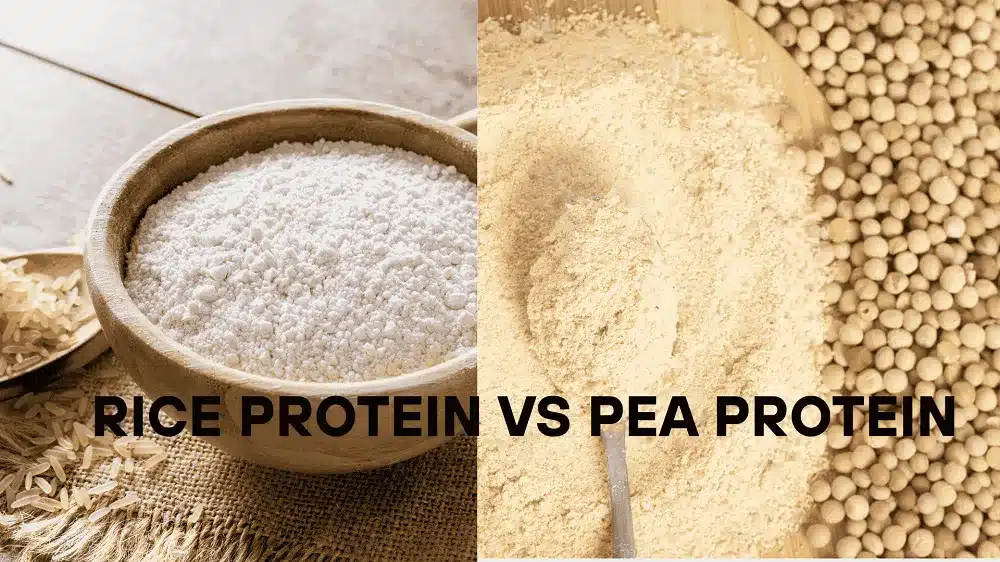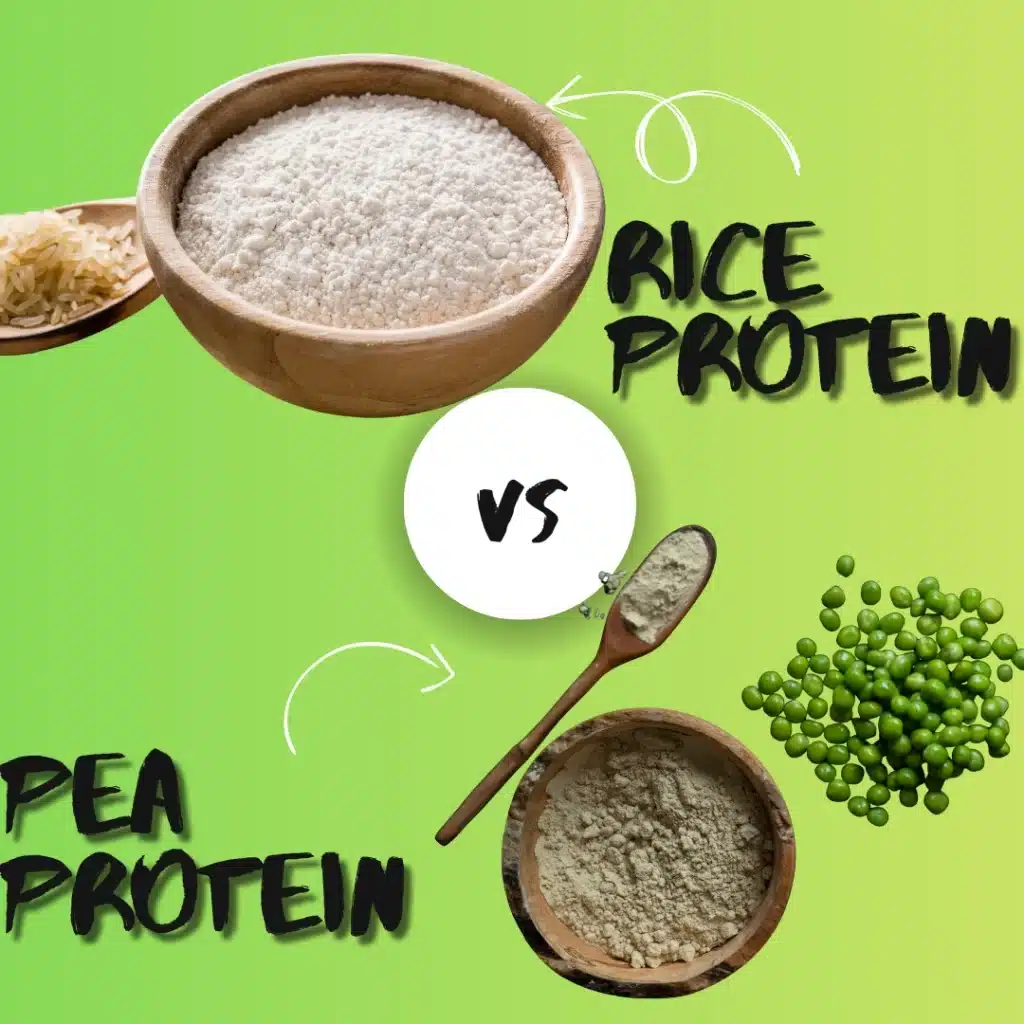Plant-based protein supplements are gaining popularity, with 米蛋白與豌豆蛋白 leading the pack for vegan, allergen-free nutrition. As the plant-based protein market grows toward $20.8 billion by 2028, choosing the right protein can support muscle growth, weight management, and overall health. As a leading supplier of 食品補充成分 和 OEM 解決方案, 我們在這裡比較 米蛋白與豌豆蛋白, covering their sources, benefits, and uses. This guide uses simple language, science-backed facts, and practical tips to help you pick the best protein for your goals, whether it’s building muscle or staying healthy.
瞭解植物性蛋白質
Proteins are the building blocks of your body, helping muscles grow, tissues repair, and energy stay high. Plant-based proteins, like 米蛋白與豌豆蛋白, are sustainable alternatives to animal proteins (e.g., whey). They’re vegan-friendly, often hypoallergenic, and eco-conscious.

Why Plant-Based?
- Supports vegan or vegetarian diets.
- Lower environmental impact than animal proteins.
- Often easier to digest for sensitive stomachs.
完整蛋白質與不完整蛋白質: A complete protein has all nine essential amino acids your body can’t make. Most plant proteins are incomplete, but combining them (e.g., rice and pea) can make them complete.
稻米蛋白質:來源與特性
米蛋白質 comes from brown rice, processed to isolate the 蛋白質 using enzymes. It’s a popular choice for its mild flavor and allergen-free profile.
來源:
- Made from whole brown rice grains.
- Minimal in regular rice dishes, so supplements provide a concentrated dose (70–80% protein).
蛋白質類型:
- 不完全蛋白質,賴氨酸含量低,但蛋氨酸和半胱氨酸含量高。
- Needs pairing with lysine-rich foods (e.g., legumes) for completeness.
主要功能:
- Hypoallergenic, great for those with food sensitivities.
- 口感順滑,是奶昔、冰沙或烘焙的理想選擇。
- Affordable and widely available in powders or bars.
Pea Protein: Sources and Characteristics
豌豆蛋白 is extracted from yellow split peas through mechanical separation. It’s a favorite for its high protein content and muscle-building potential.
來源:
- Sourced from yellow peas, a sustainable crop.
- Not found in large amounts in whole peas, making supplements key (80–85% protein).
蛋白質類型:
- Nearly complete protein, rich in lysine and branched-chain amino acids (BCAAs) like leucine.
- Lower in methionine, but closer to complete than rice protein.
主要功能:
- Highly digestible, with a PDCAAS (digestibility score) of 0.89.
- Slightly earthy taste, versatile for sweet or savory recipes.
- Supports muscle growth and satiety.
Comparing Rice Protein vs Pea Protein
以下是一張比較表,可強調以下差異 米蛋白與豌豆蛋白:
| 外觀 | 大米蛋白質 | 豌豆蛋白 |
|---|---|---|
| 來源 | 糙米 | Yellow split peas |
| 蛋白質類型 | 不完整(低賴氨酸) | Near-complete (low methionine) |
| 消化率 (PDCAAS) | 0.50-0.70 | 0.89 |
| 最適合 | Sensitive stomachs, baking | Muscle building, weight loss |
| 過敏原 | 罕見 (對米過敏) | Possible (legume allergies) |
| Taste/Texture | 平滑、溫和 | Earthy, slightly grainy |
科學說: A 2013 study in 營養期刊 found pea protein matched whey protein for muscle growth in athletes, thanks to its BCAAs. Rice protein, while less effective alone, supports muscle recovery when combined with other proteins, per a 2018 國際運動營養學會期刊 study. Blending 米蛋白與豌豆蛋白 creates a complete amino acid profile, rivaling animal proteins.
優點與應用
兩者 米蛋白與豌豆蛋白 offer unique benefits, making them ideal for different goals.
大米蛋白質的好處
- 肌肉恢復: Provides methionine for tissue repair, great for post-workout.
- 消化系統健康: Gentle on the stomach, ideal for those with allergies or sensitivities (how digestible is rice protein?).
- 體重管理:低卡路里,支持健康飲食的飽足感 (大米蛋白粉對身體有益嗎?).
Pea Protein Benefits
- 肌肉鍛鍊: High in BCAAs, effective for muscle growth (does pea protein build muscle?), per 2015 Journal of Sports Medicine 研究。
- 心臟健康: Rich in arginine, which supports blood flow.
- 減重: Increases fullness, aiding weight control (is pea protein better for weight loss?).
綜合效益
混合 米蛋白與豌豆蛋白 is a game-changer (are split peas and rice a complete protein?):
- Combines lysine (pea) and methionine (rice) for a complete protein.
- Supports muscle growth, recovery, and weight management.
- Popular in vegan protein powders for athletes and health-conscious consumers.
應用: Used in protein powders, bars, meal replacements, and shakes. Ideal for:
- Athletes building muscle (does rice protein build muscle?).
- Vegans seeking complete proteins.
- Weight loss diets needing filling, low-calorie options.
Sourcing High-Quality Rice and Pea Protein
Quality matters for effective 米蛋白與豌豆蛋白 supplements. As a trusted supplier of food supplement ingredients and OEM solutions, we ensure:
- 純淨: GMP-certified rice and pea protein powders with 80–85% protein content.
- 永續性: Organic, non-GMO options from eco-friendly sources.
- 不含過敏原:不含常見過敏原,通過第三方安全測試。
- OEM 服務:自訂混合 (例如、 米蛋白與豌豆蛋白 與 P5P 鋅和鎂)、包裝和全球合規性。
為什麼選擇我們? Our high-quality raw materials help brands create top-tier vegan protein supplements for the $20.8 billion market. We support startups and established companies with tailored formulations.
劑量和使用指南
以下是如何使用 米蛋白與豌豆蛋白 根據 ISSN 指導方針,有效地:
| 蛋白質類型 | 建議劑量 | 最佳實務 |
|---|---|---|
| 大米蛋白質 | 20-30 克/天 (肌肉);10-20 克/天 (一般) | Mix in smoothies or bake into bars |
| 豌豆蛋白 | 20-30 克/天(運動員);10-15 克/天(日常) | Blend in shakes or savory recipes |
使用提示:
- 時間: Post-workout for muscle recovery or morning for energy (can I eat pea protein every day?). Daily use is safe for most.
- 混合: Blend with water, plant milk, or smoothies. Rice protein is smoother; pea protein may need flavor masking.
- 組合: Mix rice and pea protein for a complete amino acid profile. Add P5P 鋅和鎂 以提高回收率(可在我們的 OEM 混合物中使用)。
潛在副作用與預防措施
兩者 米蛋白與豌豆蛋白 are safe for most, but here’s what to know:
大米蛋白質
- 副作用:罕見的消化系統不適;大米過敏並不常見 (is rice protein inflammatory? No evidence suggests it’s inflammatory).
- 預防措施: Safe for daily use, but consult a doctor for kidney issues or high-protein diets (can I eat pea protein every day?).
豌豆蛋白
- 副作用: Possible bloating for sensitive stomachs (what is the drawback of pea protein?). Rare legume allergies.
- 預防措施: Avoid if allergic to peas or legumes. Start with small doses to test tolerance.
一般建議: Consult a doctor if pregnant, breastfeeding, or managing conditions like kidney disease. Our high-purity proteins minimize risks with clean, tested ingredients.
比較表:實際考慮因素
本表可協助您選擇 米蛋白與豌豆蛋白:
| 因子 | 大米蛋白質 | 豌豆蛋白 | 最佳選擇 |
|---|---|---|---|
| 肌肉鍛鍊 | 中度 | Excellent (BCAAs) | Pea for athletes |
| 消化率 | 溫和、低過敏性 | High but may cause bloating | 適合敏感腸胃的米飯 |
| 味道 | Mild, smooth | Earthy, grainy | 多用途大米 |
| 成本 | Affordable | 價格稍高 | 預算大米 |
| 永續性 | 良好 | Excellent (low water use) | Pea for eco-focus |
主要心得: Choose pea protein for muscle growth and weight loss, rice protein for sensitive digestion, or a blend for complete nutrition.
總結
Rice protein vs pea protein offers unique benefits for vegan, health-conscious consumers. Rice protein is gentle and versatile, while pea protein excels for muscle building and satiety. Blending them creates a complete protein, perfect for athletes and everyday use. As a leading supplier of 米蛋白與豌豆蛋白 我們提供 GMP 認證、永續性的原料和 OEM 解決方案,協助品牌創造頂級的營養補充品。準備好推出您的素食蛋白系列了嗎?聯絡我們採購優質 米蛋白與豌豆蛋白 或為 $208 億市場開發客製化配方。
常見問題
What’s better, pea protein or rice protein?
Pea protein is better for muscle building due to BCAAs; rice protein suits sensitive stomachs (米蛋白與豌豆蛋白). Blend for complete protein.
哪種蛋白粉最健康?
Both are healthy, but pea protein’s higher digestibility (PDCAAS 0.89) and BCAA content make it slightly better for athletes. Rice is gentler for allergies (is pea better than rice?).
What’s better than pea protein?
Blends of pea and rice protein outperform pea alone by providing a complete amino acid profile, rivaling whey (are split peas and rice a complete protein?).
Is pea protein better for weight loss?
Yes, pea protein’s high satiety helps with weight loss by reducing hunger, per a 2016 Food & Nutrition Research study. Rice protein also supports weight management.
參考資料
- 美國國家衛生研究院。(2023). 運動和運動表現的飲食補充品. https://ods.od.nih.gov/factsheets/ExerciseAndAthleticPerformance-HealthProfessional/
- Joy, J. M., et al. (2013). “The effects of pea protein vs. whey protein on muscle thickness and strength.” 營養期刊doi:10.1186/1475-2891-12-86
- Gorissen, S. H. M., et al. (2018)。「市售植物性蛋白隔離物的蛋白質含量和氨基酸組成」。 國際運動營養學會期刊doi:10.1186/s12970-018-0244-0
- Babault, N., et al. (2015). “Pea proteins oral supplementation promotes muscle thickness gains.” Journal of Sports Medicine, 3(1), 3–10. doi:10.1155/2015/806485
- Dahl, W. J., et al. (2016). “Pea protein and satiety in humans.” Food & Nutrition Research, 60, 32630. doi:10.3402/fnr.v60.32630



